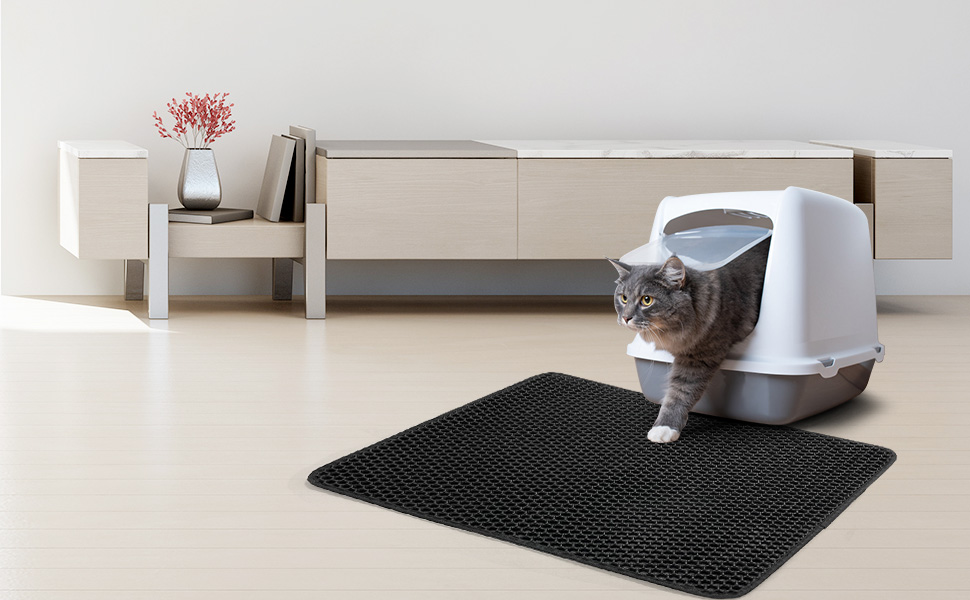A cat litter mat is one of the important cleaning requirements around the litter box. These mats prevent all the litter from spreading throughout the house. However, they require daily cleaning to continue efficiently doing their job. Moreover, this guide will help you to clean a cat litter mat quickly and easily.

Why Cleaning Your Cat Litter Mat is Important
One important thing about a cat litter mat is cleaning. It prevents the onset or formation of odour. Additionally, cleaning the mat maintains a cleaner place for your house. And finally, clean mats will never harbor bacteria, which might work against your cat’s health. Hence cleaning becomes an important routine to take up very seriously.
Step 1: Shake the Mat Outdoors
Start by shaking off the excess litter. This should be done outside to avoid spreading litter indoors. Shaking the mat outside will also help get rid of most of the debris quickly. Be sure to wear gloves during this process.
Step 2: Vacuum the Mat Thoroughly
Shake the mat and then vacuum the mat, too. These will be able to remove litter that could have been stuck deep in the fibers of your mat. Make sure there’s no smaller particle left behind after vacuuming. For mats that particularly have deep grooves, you would want a vacuum that has a brush to pull out more litter.
Step 3: Rinse the Mat with Water
You have vacuumed the mat; now is the time to rinse it. Use either a garden hose or your bathtub for rinsing the mat. Always rinse both sides of the mat properly. This will dislodge debris and dirt in your mat. Never use strong water pressure when rinsing as this can damage the mat.
Step 4: Use Mild Soap for Deeper Cleaning
To deeper clean, you can add some mild soap. Soap, however should not be strong, since mats are made of materials that cannot be exposed to hostile chemicals. So, you should be careful and gentle when using your mild soap. Once again, make sure you rinse both sides of the mat using gentle water pressure.
You can apply mild soap with warm water for deeper cleaning. Use the soapy mixture on the mat, and rub it gently. Avoid chemicals as they may harm your cat. You will require soft brushes in this type of cleaning.
Step 5: Rinse the Mat Again
Now clean the mat. In the process of cleaning, make sure that the remaining soap residue is out of the mat. The remaining soap debris irritates the paw of your cat. Ensure that you get rid of it completely. Keep on cleaning until the water gets transparent.
Step 6: Dry the Mat Completely
Let it totally dry up to be reused. You hang it out if you have space or lay flat in a dry place. Never attempt to place it in the dryer, because heat may destroy the mat. Air drying should be regarded as the safest method.
Step 7: Sprinkle Baking Soda for Odor Control
Sprinkle some baking soda on your dried-up mat. This will clean and absorb the odor on it. Then leave the baking soda for 10 to 15 minutes. Now, vacuum off for a fresh-smelling mat.
How Often Should You Clean a Cat Litter Mat?
That will depend on the number of cats. In fact, it should be cleaned at least once a week. But if your home is infested with cats, cleaning frequency would usually increase. It might need to be cleaned more often than once per week. Cleaning regularly keeps its lifespan longer and the house clean.
Tips for Maintaining a Clean Cat Litter Mat
You can clean your mat periodically. The more you use your mat, the easier it gets to work with with time. Shaking your mat every day will also rule out the possibility of any dirt formation. You can provide a rug at the bottom of the mat for prevention. Throwing in a litter mat with a non-slip bottom will prevent it from sliding quite easily.
Choosing the Right Cleaning Products
Clean the mat with feline-safe cleaning agents. Avoid bleach or other harsh disinfectants since these are extremely toxic to cats. Instead, wash using mild soap for doing dishes or a natural cleaner. Some people say white vinegar diluted with water works well.
Best Types of Litter Mats for Easy Cleaning
Some mats are easy to clean than others. Consider silicone or PVC ones as they hold less litter and usually offer a lot of durability.
Some mats, having ridges or grooves, will catch litter more but require extra care when cleaning.
How to Handle Stains and Odors
In due course of time, stains will begin to appear due to frequent use. Tough stains need a soft-bristled brush and a water or vinegar solution. Gently massage at the places. Smelling odours can be eliminated by sprinkling baking soda. You can also easily deodorize with vinegar.
Avoiding Common Mistakes While Cleaning
Some use more soap than is needed. Soap buildup from over-use irritates your cat’s paw pads. Some are not leak-proof so the mats will get wet before the next time they are used. Wet mats and consequently resultant bacteria and mold can cause health issues in you and the cat.
Final thoughts
Maintaining a clean cat litter mat is not much of an issue. With these straightforward instructions, your mat will always remain fresh and stay in use. Similarly, cleaning regularly will increase the hygiene of your house. Remember, a clean mat always has a happier cat and a cleaner living space. Follow this guide, and cleaning your cat litter mat will become swift and easy.





